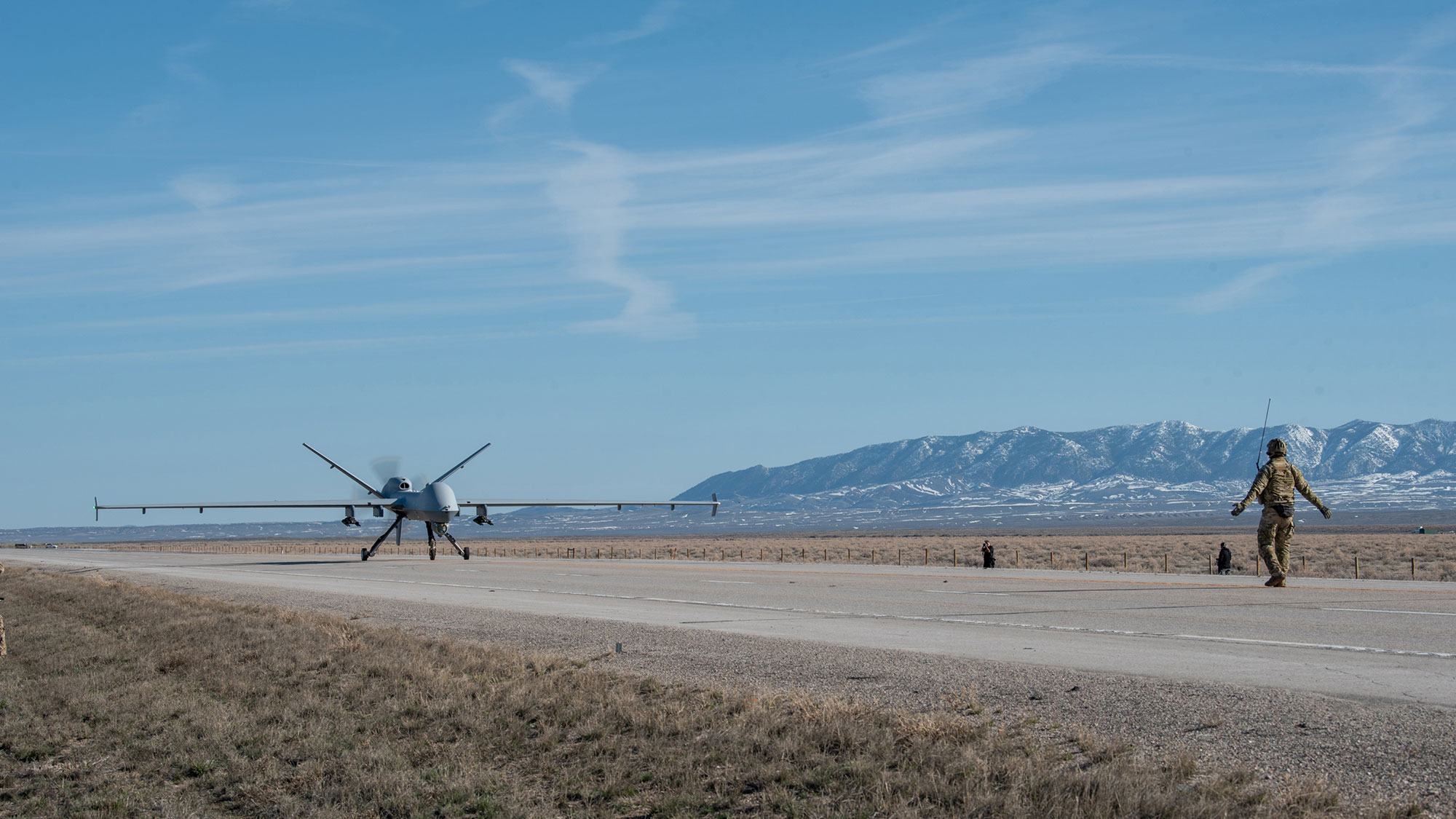

On April 30, an MQ-9 Reaper drone landed on Highway 287, north of Rawlins, Wyoming. The landing was planned; it was a part of Exercise Agile Chariot, which drew a range of aircraft and saw ground support provided by the Kentucky Air National Guard. While US aircraft have landed on highways before, this was the first time such a landing had been undertaken by a Reaper, and it demonstrates the continued viability of adapting roads into runways as the need arises.
In a video showing the landing released by the Air Force, the Reaper’s slow approach is visible against the snow-streaked rolling hills and pale-blue sky of Wyoming in spring. The landing zone is inconspicuous, a stretch of highway that could be anywhere, except for the assembled crowds and vehicles marking this particular stretch of road as an impromptu staging ground for air operations.
“The MQ-9 can now operate around the world via satellite launch and recovery without traditional launch and recovery landing sites and maintenance packages,” said Lt. Col. Brian Flanigan, 2nd Special Operations Squadron director of operations, in a release. “Agile Chariot showed once again the leash is off the MQ-9 as the mission transitions to global strategic competition.”
When Flanigan describes the Reaper as transitioning to “global strategic competition,” that’s alluding to the comparatively narrower role Reapers had over the last 15 years, in which they were a tool used almost exclusively for the counter-insurgency warfare engaged in by the United States over Iraq and Afghanistan, as well as elsewhere, like Somalia and Yemen. Reapers’ advantages shine in counter-insurgency: The drones can fly high over long periods of time, watch in precise detail and detect small movements below, and drone pilots can pick targets as the opportunity arises.

But Reapers have hard limits that make their future uncertain in wars against militaries with substantial anti-air weapons, to say nothing of flying against fighter jets. Reapers are slow, propeller-driven planes, built for endurance not speed, and could be picked out of the sky or, worse, destroyed on a runway by a skilled enemy with dedicated anti-plane weaponry.
In March, a Reaper flying over the Black Sea was sprayed by fuel released from a Russian jet, an incident that led it to crash. While Wyoming’s Highway 287 is dangerous for cars, for planes it has the virtue of being entirely in friendly air space.
Putting a Reaper into action in a war against a larger military, which in Pentagon terms often means against Russia or China, means finding a way to make the Reaper useful despite those threats. Such a mission would have to take advantage of the Reaper’s long endurance flight time, surveillance tools, and precision strike abilities, without leaving it overly vulnerable to attack. Operating on highways as runways is one way to overcome that limit, letting the drone fly from whenever there is road.
“An adversary that may be able to deny use of a military base or an airfield, is going to have a nearly impossible time trying to defend every single linear mile of roads. It’s just too much territory for them to cover and that gives us access in places and areas that they can’t possibly defend,” Lt. Col. Dave Meyer, Deputy Mission Commander for Exercise Agile Chariot, said in a release.
Alongside the Reaper, the exercise showcased MC-130Js, A-10 Warthogs, and MH-6M Little Bird helicopters. With soldiers first establishing landing zones along the highway, the exercise then demonstrated landing the C-130 cargo aircraft to use as a refueling and resupply point for the A-10s, which also operated from the highway. Having the ability to not just land on an existing road, but bring more fuel and spare ammunition to launch new missions from the same road, makes it hard for an adversary to permanently ground planes, as resupply is also air-mobile and can use the same improvised runways.
Part of the exercise took place on Highway 789, which forks off 287 between Lander and Riverton, as the setting for trial search and rescue missions. “On the second day of operations, they repeated the procedure of preparing a landing zone for an MC-130. Once the aircraft landed, the team boarded MH-6 Little Birds that had been offloaded from the cargo plane by Soldiers from the 160th Special Operations Aviation Regiment. The special tactics troops then performed combat search-and-rescue missions to find simulated injured pilots and extract them from the landing zone on Highway 789,” described the Kentucky Air National Guard, in a statement.
With simulated casualties on cleared roads, the Air Force rehearsed for the tragedy of future war. As volunteers outfitted in prosthetic injuries were transported back to the care and safety of landed transports, the highways in Wyoming were home to the full spectrum of simulated war from runways. Watch a video of the landing, below.
